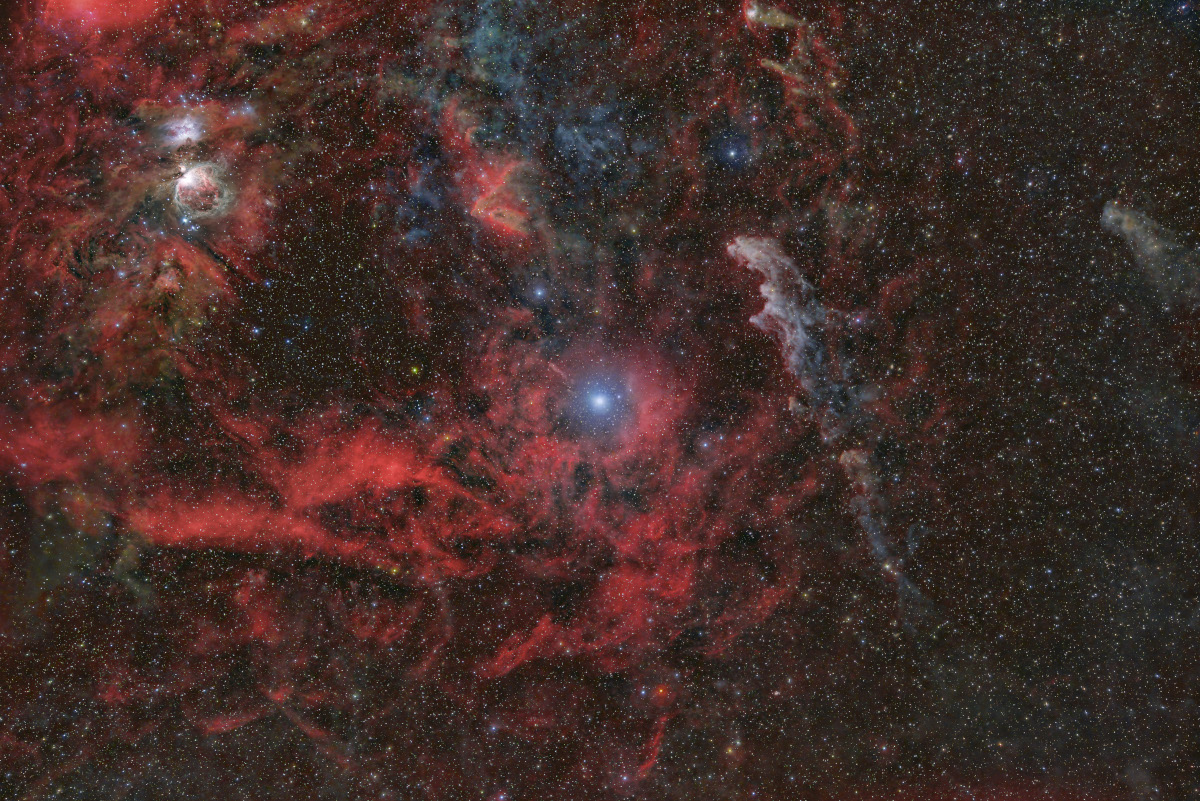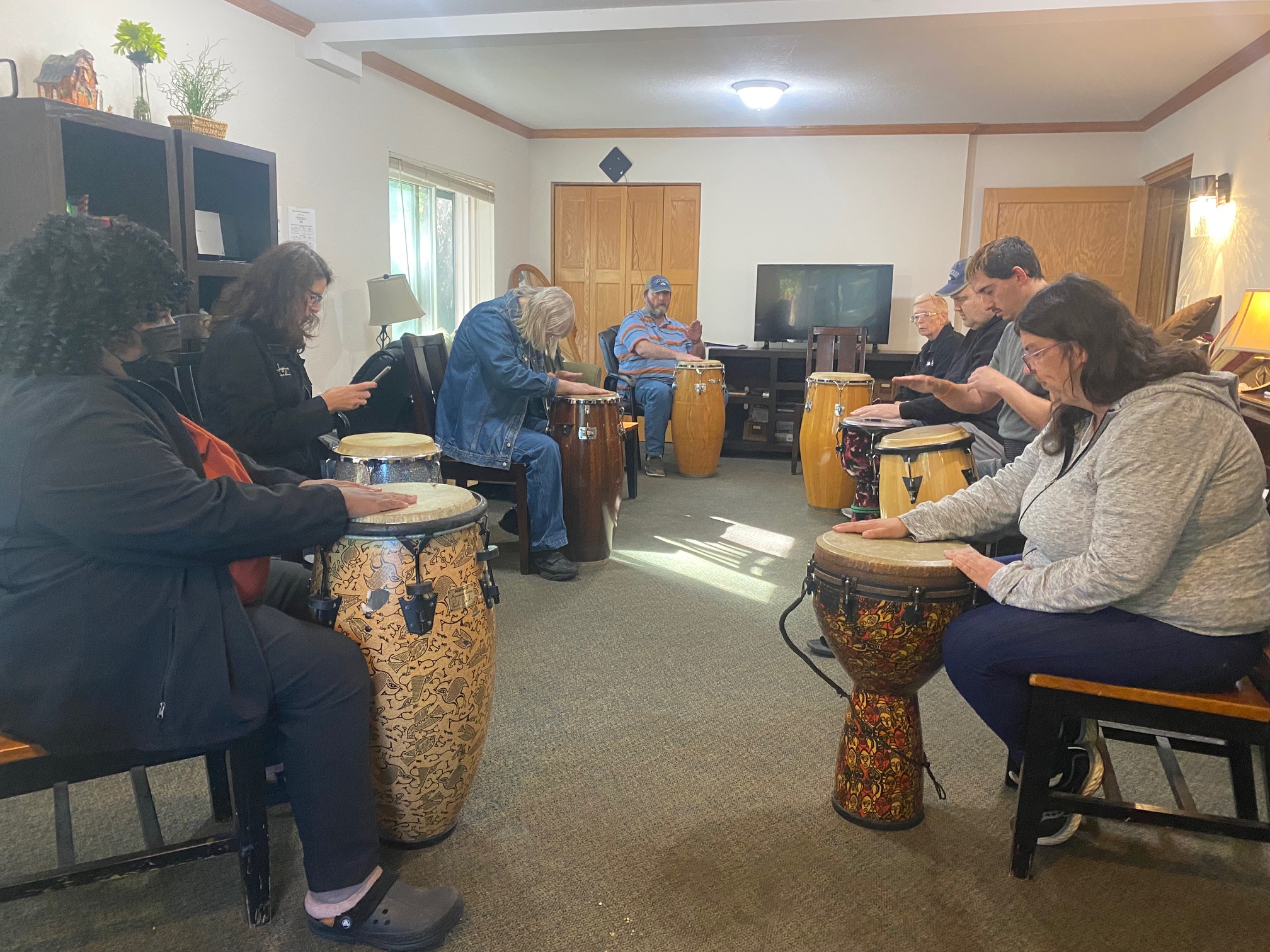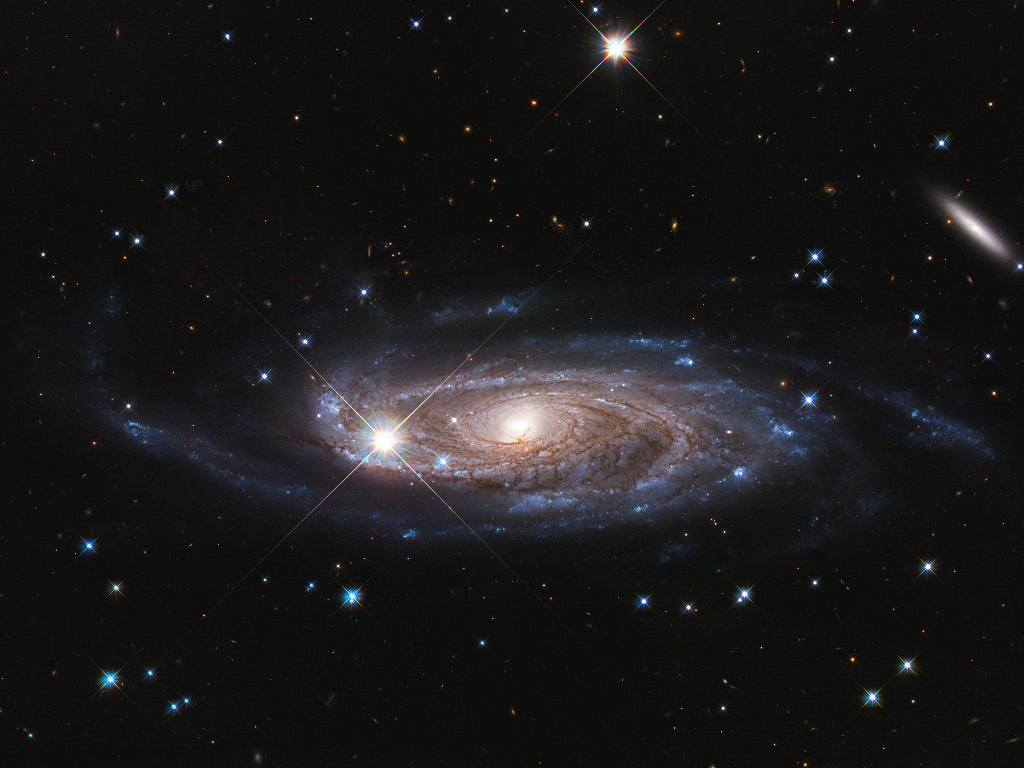Blog
Brilliant, blue, supergiant star Rigel marks the foot of Orion the Hunter in planet Earth’s night. Designated Beta Orionis, it’s at the center of this remarkably deep and wide field of view. Rigel’s blue color indicates that it is much hotter than its rival supergiant in Orion the yellowish Betelgeuse (Alpha Orionis), though both stars are massive enough to eventually end their days as core collapse supernovae. Some 860 light-years away, Rigel is hotter than the Sun too and extends to about 74 times the solar radius. That’s about the size of the orbit of Mercury. In the 10 degree wide frame toward the nebula rich constellation, the Orion Nebula is at the upper left. To the right of Rigel and illuminated by its brilliant blue starlight lies the dusty Witch Head Nebula. Rigel is part of a multiple star system, though its companion stars are much fainter.

more...
Frederick Dewayne Hubbard (April 7, 1938 – December 29, 2008) was an American jazz trumpeter. He played bebop, hard bop, and post-bop styles from the early 1960s onwards. His unmistakable and influential tone contributed to new perspectives for modern jazz and bebop.
Hubbard started playing the mellophone and trumpet in his school band at Arsenal Technical High School in Indianapolis, Indiana. Trumpeter Lee Katzman, former sideman with Stan Kenton, recommended that he begin studying at the Arthur Jordan Conservatory of Music (now the Jordan College of the Arts at Butler University) with Max Woodbury, the principal trumpeter of the Indianapolis Symphony Orchestra. In his teens, Hubbard worked locally with brothers Wes and Monk Montgomery, and worked with bassist Larry Ridleyand saxophonist James Spaulding. In 1958, at the age of 20, he moved to New York and began playing with some of the best jazz players of the era, including Philly Joe Jones, Sonny Rollins, Slide Hampton, Eric Dolphy, J. J. Johnson, and Quincy Jones. On June 19, 1960, Hubbard made his first record as a leader, Open Sesame, at the beginning of his contract with Blue Note Records, with saxophonist Tina Brooks, pianist McCoy Tyner, bassist Sam Jones, and drummer Clifford Jarvis. Six days later he returned the favor to Brooks and recorded with him on True Blue.
more...Ravi Shankar, KBE, LH ; born Robindro Shaunkor Chowdhury,sometimes spelled as Rabindra Shankar Chowdhury; 7 April 1920 – 11 December 2012) was an Indian sitarist and composer. A sitar virtuoso, he became the world’s best-known export of North Indian classical music in the second half of the 20th century, and influenced many musicians in India and throughout the world. Shankar was awarded India’s highest civilian honour, the Bharat Ratna, in 1999.
Shankar was born to a Bengali Brahmin family in India, and spent his youth as a dancer touring India and Europe with the dance group of his brother Uday Shankar. He gave up dancing in 1938 to study sitar playing under court musician Allauddin Khan. After finishing his studies in 1944, Shankar worked as a composer, creating the music for the Apu Trilogy by Satyajit Ray, and was music director of All India Radio, New Delhi, from 1949 to 1956.
In 1956, Shankar began to tour Europe and the Americas playing Indian classical music and increased its popularity there in the 1960s through teaching, performance, and his association with violinist Yehudi Menuhin and Beatles guitarist George Harrison. His influence on Harrison helped popularize the use of Indian instruments in Western pop music in the latter half of the 1960s. Shankar engaged Western music by writing compositions for sitar and orchestra and toured the world in the 1970s and 1980s. From 1986 to 1992, he served as a nominated member of Rajya Sabha, the upper chamber of the Parliament of India. He continued to perform until the end of his life. He’s a recipient of numerous prestigious musical accolades, including a Polar Music Prize and five Grammy Awards. Shankar was born on 7 April 1920 in Benares (now Varanasi), then the capital of the eponymous princely state, in a Bengali family, as the youngest of seven brothers.
more...Ramón “Mongo” Santamaría Rodríguez (April 7, 1917 – February 1, 2003) was a Cuban percussionist and bandleader who spent most of his career in the United States. Primarily a conga drummer, Santamaría was a leading figure in the pachanga and boogaloo dance crazes of the 1960s. His biggest hit was his rendition of Herbie Hancock‘s “Watermelon Man“, which was inducted into the Grammy Hall of Fame in 1998. From the 1970s, he recorded mainly salsa and Latin jazz, before retiring in the late 1990s.
Mongo learned to play the congas as an amateur rumba musician in the streets of Havana. He then learned the bongos from Clemente “Chicho” Piquero and toured with various successful bands such as the Lecuona Cuban Boys and Sonora Matancera. In 1950, he moved to New York City, where he became Tito Puente‘s conguero and in 1957 he joined Cal Tjader‘s band. He then formed his own charanga, while at the same time recording some of the first rumba and Santería music albums. By the end of the decade, he had his first pachanga hit, “Para ti”. He then became a pioneer of boogaloo with “Watermelon Man” and later signed record deals with Columbia, Atlantic and Fania. He collaborated with salsa artists and became a member of the Fania All-Stars, often showcasing his conga solos against Ray Barretto. In his later years, Santamaría recorded mostly Latin jazz for Concord Jazz and Chesky Records.
Santamaría learned rumba as a kid in the streets of Havana’s Jesús María neighborhood. He reminisced: “In the neighborhood where I came from we had all kinds of music, mostly from Africa. We did not leave it alone; we changed it our way. The music we made dealt with religion and conversation.
more...Billie Holiday (born Eleanora Fagan; April 7, 1915 – July 17, 1959) was an American jazz and swing musicsinger. Nicknamed “Lady Day” by her friend and music partner, Lester Young, Holiday had an innovative influence on jazz music and pop singing. Her vocal style, strongly inspired by jazz instrumentalists, pioneered a new way of manipulating phrasing and tempo. She was known for her vocal delivery and improvisational skills.
After a turbulent childhood, Holiday began singing in nightclubs in Harlem, where she was heard by producer John Hammond, who liked her voice. She signed a recording contract with Brunswick in 1935. Collaborations with Teddy Wilson produced the hit “What a Little Moonlight Can Do“, which became a jazz standard. Throughout the 1930s and 1940s, Holiday had mainstream success on labels such as Columbia and Decca. By the late 1940s, however, she was beset with legal troubles and drug abuse. After a short prison sentence, she performed at a sold-out concert at Carnegie Hall. She was a successful concert performer throughout the 1950s with two further sold-out shows at Carnegie Hall. Because of personal struggles and an altered voice, her final recordings were met with mixed reaction but were mild commercial successes. Her final album, Lady in Satin, was released in 1958. Holiday died of cirrhosis on July 17, 1959, at age 44.
Holiday won four Grammy Awards, all of them posthumously, for Best Historical Album. She was inducted into the Grammy Hall of Fame and the National Rhythm & Blues Hall of Fame. She was also inducted into the Rock & Roll Hall of Fame, though not in that genre; the website states that “Billie Holiday changed jazz forever”. Several films about her life have been released, most recently The United States vs. Billie Holiday(2021).
Eleanora Fagan was born on April 7, 1915, in Philadelphia, the daughter of African American unwed teenage couple Sarah Julia “Sadie” Fagan of Irish descent and Clarence Halliday. Sarah moved to Philadelphia at age 19, after she was evicted from her parents’ home in the Sandtown-Winchester neighborhood of Baltimore, Maryland, for becoming pregnant. With no support from her parents, she made arrangements with her older, married half-sister, Eva Miller, for Eleanora to stay with her in Baltimore. Not long after Eleanora was born, Clarence abandoned his family to pursue a career as a jazz banjo player and guitarist.
more...Most of the world first heard Rumba Flamenca via the Gypsy Kings in songs like Bamboleo and Volare. In Spain, Rumba Flamenca has come in and out of style since Niña de los Peines first recorded a Rumba in 1918. Since then, artists such as El Chaqueta, Chano Lobato and Miguel Vargas Jiménez (Bambino) have become closely associated with the form. Apart from the Gypsy Kings, one of the reasons Rumba Flamenca is heard throughout the world is that it is such a flexible, easily adapted form. It c an occur in any key or mode. Phrase lengths can be long or short. Tempos can be quick and driven or easy and relaxed. It’s party music that can be carefully composed or improvised on the spot. As long as it has a steady Rumba Flamenca beat, it’s Rumba Flamenca. Rumba Flamenca is a fast 2/4 rhythm driven largely by a distinctive strum pattern on the guitar. However, the form is so open that not even this is required.
more...Happy Birthday to my oldest grand baby. Carson Sheftic 16 years old today. Living in Pittsburg.

On the morning of this Saturday, February 25, I photographed our sun full of activity. Undoubtedly, several prominences stand out in this photograph. The one that can be seen in the southwestern limb is really huge, reaching a height of about 70,000 km and a width of 200,000 km. Another very interesting thing to mention is the filament that can be seen at the top right, associated with the AR3229 sunspot, this plasma structure exploded at 19:49 UTC.

Gerald Joseph Mulligan (April 6, 1927 – January 20, 1996), also known as Jeru, was an American jazzsaxophonist, clarinetist, composer and arranger. Though primarily known as one of the leading jazz baritone saxophonists—playing the instrument with a light and airy tone in the era of cool jazz—Mulligan was also a significant arranger, working with Claude Thornhill, Miles Davis, Stan Kenton, and others. His pianoless quartet of the early 1950s with trumpeter Chet Baker is still regarded as one of the best cool jazz groups. Mulligan was also a skilled pianist and played several other reed instruments. Several of his compositions, such as “Walkin’ Shoes” and “Five Brothers”, have become standards.
Gerry Mulligan was born in Queens Village, Queens, New York, United States, the son of George and Louise Mulligan. His father was a Wilmington, Delaware, native of Irish descent; his mother a Philadelphia native of half-Irish and half-German descent. Gerry was the youngest of four sons with George, Phil and Don preceding him.
more...John Paul Pizzarelli Jr. (born April 6, 1960) is an American jazz guitarist and vocalist. He has recorded over twenty solo albums and has appeared on more than forty albums by other recording artists, including Paul McCartney, James Taylor, Rosemary Clooney; his father, jazz guitarist Bucky Pizzarelli; and his wife, singer Jessica Molaskey.
The son of swing guitarist Bucky Pizzarelli, John Pizzarelli was born in Paterson, New Jersey. He started on guitar when he was six and played trumpet through his college years. He attended Don Bosco Preparatory High School, an all-boys Catholic school. In his teens, he performed with Benny Goodman, Les Paul, Zoot Sims, Slam Stewart, and Clark Terry.
more...Beverly “Guitar” Watkins (April 6, 1939 – October 1, 2019) was an American blues guitarist. Sandra Pointer-Jones wrote, “Beverly Watkins is a pyrotechnic guitar maven whose searing, ballistic attacks on the guitar have become allegorical tales within the blues community.” George Varga, reviewing her debut CD, observed that Watkins “sings and plays with enough poise and verve to make musicians half her age or younger consider alternative means of employment.”
Watkins was born in Atlanta, Georgia in 1939. When she was about 12 years old, her family moved to Commerce, Georgia. She began playing music in school, and, in high school, she played bass for a band called Billy West Stone and the Down Beats. Around the year 1959, she was introduced to Piano Red, who had a daily radio show on WAOK, and she subsequently joined Piano Red and the Meter-tones, who played in a number of towns in the Atlanta area, and then Atlanta clubs such as the Magnolia Ballroom and the Casino, before starting to tour throughout the southeast, primarily at colleges.
more...Randolph Edward “Randy” Weston (April 6, 1926 – September 1, 2018) was an American jazz pianist and composer whose creativity was inspired by his ancestral African connection.
Weston’s piano style owed much to Duke Ellington and Thelonious Monk, whom he cited in a 2018 video as among pianists he counted as influences, as well as Count Basie, Nat King Cole and Earl Hines.Beginning in the 1950s, Weston worked often with trombonist and arranger Melba Liston.
Described as “America’s African Musical Ambassador”, Weston once said: “What I do I do because it’s about teaching and informing everyone about our most natural cultural phenomenon. It’s really about Africa and her music.”
Randolph Edward Weston was born on April 6, 1926, to Vivian (née Moore) and Frank Weston and was raised in Brooklyn, New York, where his father owned a restaurant. His mother was from Virginia and his father was of Jamaican–Panamanian descent, a staunch Garveyite, who passed self-reliant values to his son. Weston studied classical piano as a child and took dance lessons.
more...Charlie Rouse (April 6, 1924 – November 30, 1988) was an American hard bop tenor saxophonist and flautist. His career is marked by his collaboration with Thelonious Monk, which lasted for more than ten years. Rouse was born in Washington, D.C., United States. At first he worked with the clarinet, before turning to the tenor saxophone. Rouse began his career with the Billy Eckstine Orchestra in 1944, followed by the Dizzy Gillespie Big Band in 1945, the Duke Ellington Orchestra from 1949 to 1950, the Count Basie Octet in 1950, Bull Moose JacksonAnd His Buffalo Bearcats in 1953, and the Oscar Pettiford Sextet in 1955. He made his recording debut with Tadd Dameron in 1947, and in 1957 made a notable album with Paul Quinichette.
He was a member of Thelonious Monk‘s quartet from 1959 to 1970. In the 1980s he was a founding member of the group Sphere, which began as a tribute to Monk.
Charlie Rouse died from lung cancer on November 30, 1988, at University Hospital in Seattle at the age of 64.
more...Teaching a Rhythm Roots Workshop Wednesday April 5th 2023 11am-1230pm. Tasks Unlimited provides supported employment, housing and recovery services to create opportunities for people with mental illness so they can achieve their full potential.

In this Hubble Space Telescope image the bright, spiky stars lie in the foreground toward the heroic northern constellation Perseus and well within our own Milky Way galaxy. In sharp focus beyond is UGC 2885, a giant spiral galaxy about 232 million light-years distant. Some 800,000 light-years across compared to the Milky Way’s diameter of 100,000 light-years or so, it has around 1 trillion stars. That’s about 10 times as many stars as the Milky Way. Part of an investigation to understand how galaxies can grow to such enormous sizes, UGC 2885 was also part of An Interesting Voyage and astronomer Vera Rubin’s pioneering study of the rotation of spiral galaxies. Her work was the first to convincingly demonstrate the dominating presence of dark matter in our universe.

more...
Harold Allan Clarke (born 5 April 1942) is an English rock singer, who was one of the founding members and the original lead singer of the Hollies. He achieved international hit singles with the group and is credited as co-writer on several of their best-known songs, including “On a Carousel“, “Carrie Anne“, “Jennifer Eccles” and “Long Cool Woman in a Black Dress“. He retired from performing in 1999, but returned to the music industry in 2019. Clarke was inducted into the Rock and Roll Hall of Fame in 2010.
Harold Allan Clarke and his childhood friend Graham Nash began singing together in Manchester while still at school. They formed the Hollies in December 1962 with Vic Steele (lead guitar) and Eric Haydock (bass guitar). In April 1963, they added Tony Hicks (replacing Steele on lead guitar) and Bobby Elliott (replacing Don Rathbone on drums).
more...More Posts
- How Far Will It Go
- Echos of Freedom Coretta Scott King
- Cosmo Blue Ghost
- Samuel Barber
- Lloyd Price
- Zakir Hussain
- Ornette Coleman
- World Music Jam & Zaki Project
- Daily Roots The Observers
- Ukraine Shark
- International Women’s Day 2025
- Mississippi John Hurt
- Cosmo Milky Way LMC SMC
- Richard Fariña
- Johnny Ventura
- Gábor Szabó
- George Coleman
- Ina Boyle
- World Music Andalucious
- Daily Roots Sly and the Revolutionaries